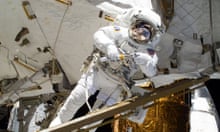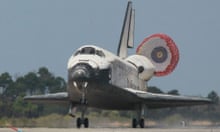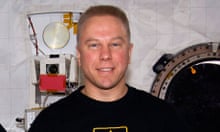Almost 200 people from 15 countries have visited the international space station, but until now all the crew have been human. This week the station will get its first humanoid robot.
Robonaut 2 (nicknamed, inevitably, R2) will ride on the final flight of space shuttle Discovery this week and spend the next decade helping astronauts on the space station with scientific research and mundane chores.
The $2.5m (£1.6m) robot, made from aluminium and nickel-plated carbon fibre, stands almost a metre tall and weighs 136kg (300lb). Among more than 40 sensors used to detect its surroundings are four visible-light cameras in its golden head sitting in place of eyes, and a fifth in its mouth to measure infrared light and help with depth perception. R2's 38 computer processors fill up the stomach area, firing commands to its highly dexterous arms and fingers.
"Initially, R2's primary role on the space station will be experimental," according to a Nasa briefing. "The robot will begin its life in space stationed in the Destiny laboratory, where it will be put through tasks and operations similar to ones it has performed on Earth, which will allow engineers to work out the pitfalls of operating a dexterous humanoid robot in space. As R2 proves its mettle, the robot may graduate to station maintenance tasks, such as vacuuming or cleaning filters. And with upgrades that would allow it to function in the vacuum of space, it could also perform repairs on the outside of the station or simply help astronauts with work outside."
The initial work on the concept began in 1997, the idea being to build a robot that could help astronauts in space on tasks that were too dangerous, or too boring. The first version of the Robonaut, R1, was a human-like machine that could perform maintenance tasks or even explore the surface of the moon if attached to wheels – but there was insufficient funding to take the prototype out of the lab. The project was saved by General Motors in 2007. After a joint project with Nasa, the car company unveiled R2 in February 2010. It is a faster and more dexterous version of R1 and Nasa decided to test it out in space, scheduling it to hitch a ride on one of the last space shuttle missions.
At the moment R2 is only an upper body but if initial tests prove positive it could be given legs and software upgrades to allow it and its successors to service communications and weather satellites and even explore asteroids, comets or the moons of Mars."There is a logical progression for the next generation of space exploration," said Nasa. "Our first look at a new destination is through a telescope, then through the eyes of a robotic precursor such as R2, followed by the arrival of human explorers. Humans and robots exploring the solar system together will provide greater results than either could achieve alone, enabling an exciting future of new discoveries."



